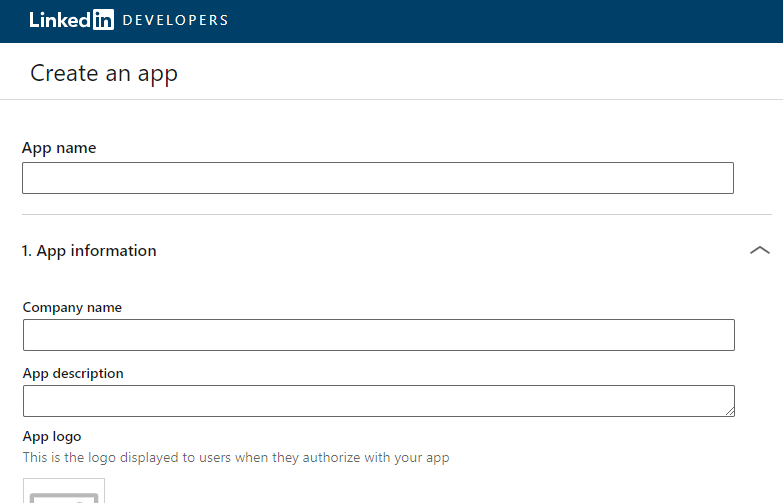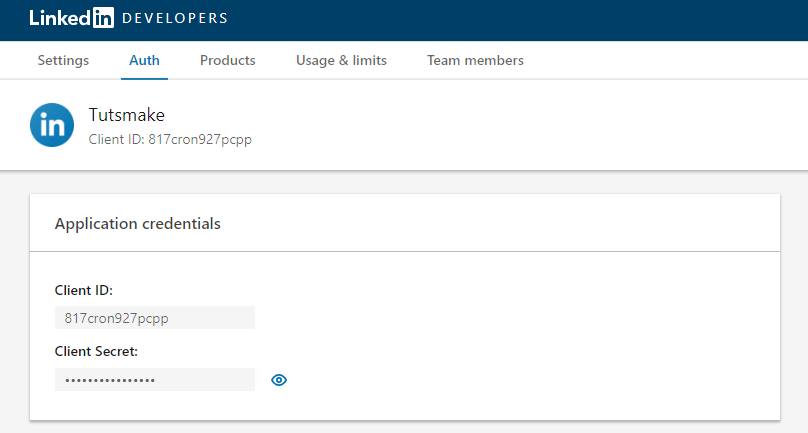Laravel 9 socialite login with LinkedIn account; In this tutorial, we will learn how to integrate LinkedIn login in laravel 9 app using the socialite package.
How to Integrate Login with LinkedIn in Laravel 9 Using Socialite Package
Use the following steps to integrate LinkedIn login in laravel 9 apps:
- Step 1 – Install Laravel 9 App
- Step 2 – Connecting App to Database
- Step 3 – Configure the Linkedin App
- Step 4 – Install Socialite & Configure
- Step 5 – Add Field In Table Using Migration
- Step 6 – Install Jetstream Auth
- Step 7 – Make Routes
- Step 8 – Create Linkedin Login Controller By Command
- Step 9 – Integrate Linkedin Login Button In Login Page
- Step 10 – Start Development Server
Before starting the tutorial, we need to know how to get client id and secret of Linkedin app from Linkedin Developer Console, then you can create Linkedin App in Linkedin Developer Console by following the steps given below.
Step 1:- create linkedin app by click the following url :- https://www.linkedin.com/developers/apps/new . And create linkedin app.
When you click the above given url the following below page will be displayed. So fill the details and create your linkedin app:

Step 2:- After successfully create the app set the redirect URL for example :

Step 3:- Finally, you redirect to dashboard by linkedin.com. So you can copy client id and secret from linkedin app dashboard like following picture:

Now linkedin app has been created successfully.
Step 1 – Install Laravel 9 App
In this step, open your terminal and navigate to local web server directory. Then type the following command on terminal to download laravel 9 app:
composer create-project --prefer-dist laravel/laravel Laravel9Linkedin
Step 2 – Connecting App to Database
Next step, navigate to root directory of download laravel app. And open .env file. Then configure database details like following:
DB_CONNECTION=mysql
DB_HOST=127.0.0.1
DB_PORT=3306
DB_DATABASE=here your database name here
DB_USERNAME=here database username here
DB_PASSWORD=here database password here
Step 3 – Configure Linkedin App
In this step, configure Linkedin app with this laravel app. So, open your laravel Linkedin social login project in any text editor. Then navigate the config directory and open service.php file and add the client id, secret and callback url:
'linkedin' => [ 'client_id' => 'xxxx', 'client_secret' => 'xxx', 'redirect' => 'http://127.0.0.1:8000/callback/linkedin', ],
Step 4 – Install Socialite & Configure
In this step, use the following command to install socialite package in laravel 9 app:
composer require laravel/socialite
After that, configure this package in app.php file, so go to config directory and open app.php file.
Then Add the ServiceProvider in config/app.php:
'providers' => [
/*
* Package Service Providers...
*/
Laravel\Socialite\SocialiteServiceProvider::class,
]
Then add the Facade in config/app.php:
'aliases' => [
...
'Socialite' => Laravel\Socialite\Facades\Socialite::class,
]
Step 5 – Add Field In Table Using Migration
In this step, use the following command to create migration file for add column in database table:
php artisan make:migration add_social_login_field
After that, open the add_social_login_field.php file, which is found inside database/migration directory and add the following code into it:
<?php
use Illuminate\Support\Facades\Schema;
use Illuminate\Database\Schema\Blueprint;
use Illuminate\Database\Migrations\Migration;
class AddSoicalLoginField extends Migration
{
/**
* Run the migrations.
*
* @return void
*/
public function up()
{
Schema::table('users', function ($table) {
$table->string('social_id')->nullable();
$table->string('social_type')->nullable();
});
}
/**
* Reverse the migrations.
*
* @return void
*/
public function down()
{
Schema::table('users', function ($table) {
$table->dropColumn('social_id');
$table->dropColumn('social_type');
});
}
}
After successfully add field in database table. Then add fillable property in User.php model, which is found inside app/Models/ directory:
<?php
namespace App\Models;
use Illuminate\Contracts\Auth\MustVerifyEmail;
use Illuminate\Database\Eloquent\Factories\HasFactory;
use Illuminate\Foundation\Auth\User as Authenticatable;
use Illuminate\Notifications\Notifiable;
use Laravel\Fortify\TwoFactorAuthenticatable;
use Laravel\Jetstream\HasProfilePhoto;
use Laravel\Sanctum\HasApiTokens;
class User extends Authenticatable
{
use HasApiTokens;
use HasFactory;
use HasProfilePhoto;
use Notifiable;
use TwoFactorAuthenticatable;
/**
* The attributes that are mass assignable.
*
* @var array
*/
protected $fillable = [
'name',
'email',
'password',
'social_id',
'social_type'
];
/**
* The attributes that should be hidden for arrays.
*
* @var array
*/
protected $hidden = [
'password',
'remember_token',
'two_factor_recovery_codes',
'two_factor_secret',
];
/**
* The attributes that should be cast to native types.
*
* @var array
*/
protected $casts = [
'email_verified_at' => 'datetime',
];
/**
* The accessors to append to the model's array form.
*
* @var array
*/
protected $appends = [
'profile_photo_url',
];
}
After that, execute the following command on cmd to create tables into your selected database:
php artisan migrate
Step 6 – Install Jetstream Auth
In this step, install jetstream laravel auth scaffolding package with livewire. We have provided a complete guide in this Laravel 9 Auth Scaffolding using Jetstream Tutorial.
Step 7 – Make Routes
In this step, Go to routes directory and open web.php file. Then add the following routes into web.php file:
use Illuminate\Support\Facades\Route;
use App\Http\Controllers\Auth\LinkedinSocialiteController;
Route::get('auth/linkedin', [LinkedinSocialiteController::class, 'redirectToLinkedin']);
Route::get('callback/linkedin', [LinkedinSocialiteController::class, 'handleCallback']);
Step 8 – Create Linkedin Login Controller By Command
In this step, Execute the following command on terminal to create LinkedinSocialiteController.php file:
php artisan make:controller LinkedinSocialiteController
After that, Go to app/http/controllers directory and open LinkedinSocialiteController.php file in any text editor. Then add the following code into LinkedinSocialiteController.php file:
<?php
namespace App\Http\Controllers\Auth;
use App\Http\Controllers\Controller;
use Socialite;
use Auth;
use Exception;
use App\Models\User;
class LinkedinSocialiteController extends Controller
{
/**
* Create a new controller instance.
*
* @return void
*/
public function redirectToLinkedin()
{
return Socialite::driver('linkedin')->redirect();
}
/**
* Create a new controller instance.
*
* @return void
*/
public function handleCallback()
{
try {
$user = Socialite::driver('linkedin')->user();
$finduser = User::where('social_id', $user->id)->first();
if($finduser){
Auth::login($finduser);
return redirect('/home');
}else{
$newUser = User::create([
'name' => $user->name,
'email' => $user->email,
'social_id'=> $user->id,
'social_type'=> 'linkedin',
'password' => encrypt('my-linkedin')
]);
Auth::login($newUser);
return redirect('/home');
}
} catch (Exception $e) {
dd($e->getMessage());
}
}
}
Step 9 – Integrate Linkedin Login Button In Login Page
In this step, integrate linkedin login button into login.blade.php file. So, open login.blade.php, which is found inside resources/views/auth/ directory:
<x-guest-layout>
<x-jet-authentication-card>
<x-slot name="logo">
<x-jet-authentication-card-logo />
</x-slot>
<x-jet-validation-errors class="mb-4" />
@if (session('status'))
<div class="mb-4 font-medium text-sm text-green-600">
{{ session('status') }}
</div>
@endif
<form method="POST" action="{{ route('login') }}">
@csrf
<div>
<x-jet-label value="{{ __('Email') }}" />
<x-jet-input class="block mt-1 w-full" type="email" name="email" :value="old('email')" required autofocus />
</div>
<div class="mt-4">
<x-jet-label value="{{ __('Password') }}" />
<x-jet-input class="block mt-1 w-full" type="password" name="password" required autocomplete="current-password" />
</div>
<div class="block mt-4">
<label class="flex items-center">
<input type="checkbox" class="form-checkbox" name="remember">
<span class="ml-2 text-sm text-gray-600">{{ __('Remember me') }}</span>
</label>
</div>
<div class="flex items-center justify-end mt-4">
@if (Route::has('password.request'))
<a class="underline text-sm text-gray-600 hover:text-gray-900" href="{{ route('password.request') }}">
{{ __('Forgot your password?') }}
</a>
@endif
<x-jet-button class="ml-4">
{{ __('Login') }}
</x-jet-button>
<a href="{{ url('auth/linkedin') }}" style="margin-top: 0px !important;background: green;color: #ffffff;padding: 5px;border-radius:7px;" class="ml-2">
<strong>Linkedin Login</strong>
</a>
</div>
</form>
</x-jet-authentication-card>
</x-guest-layout>
Step 10 – Start Development Server
In this step, start the development server by executing PHP artisan serve command on terminal:
php artisan serve
Now open browser and hit the following urls on it:
http://127.0.0.1:8000